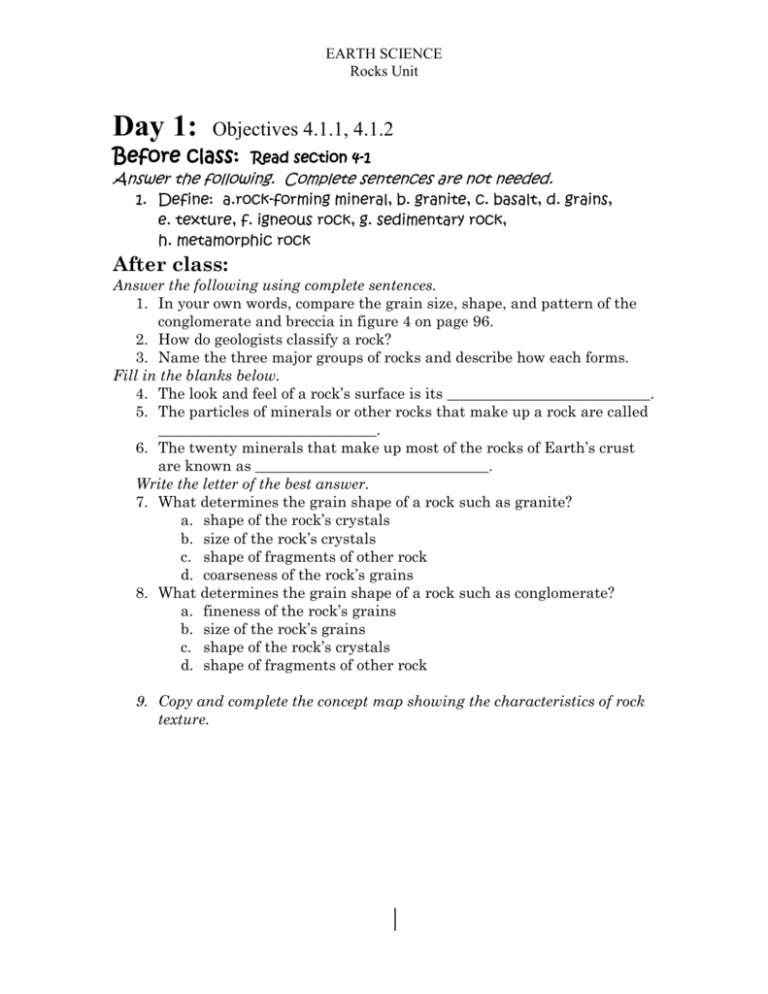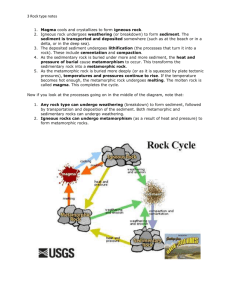earth sci rocks day homework - wbm-earth
advertisement

EARTH SCIENCE Rocks Unit Day 1: Objectives 4.1.1, 4.1.2 Before class: Read section 4-1 Answer the following. Complete sentences are not needed. 1. Define: a.rock-forming mineral, b. granite, c. basalt, d. grains, e. texture, f. igneous rock, g. sedimentary rock, h. metamorphic rock After class: Answer the following using complete sentences. 1. In your own words, compare the grain size, shape, and pattern of the conglomerate and breccia in figure 4 on page 96. 2. How do geologists classify a rock? 3. Name the three major groups of rocks and describe how each forms. Fill in the blanks below. 4. The look and feel of a rock’s surface is its ___________________________. 5. The particles of minerals or other rocks that make up a rock are called _____________________________. 6. The twenty minerals that make up most of the rocks of Earth’s crust are known as _______________________________. Write the letter of the best answer. 7. What determines the grain shape of a rock such as granite? a. shape of the rock’s crystals b. size of the rock’s crystals c. shape of fragments of other rock d. coarseness of the rock’s grains 8. What determines the grain shape of a rock such as conglomerate? a. fineness of the rock’s grains b. size of the rock’s grains c. shape of the rock’s crystals d. shape of fragments of other rock 9. Copy and complete the concept map showing the characteristics of rock texture. EARTH SCIENCE Rocks Unit Rock Texture includes Grain size includes includes includes jagged grain nonbanded coarse grain Day 2: Objectives 4.2.1, 4.2.2 Before class: Read section 4-2 Answer the following. Complete sentences are not needed. 1. Define: a. extrusive rock, b. intrusive rock, c. silica 2. What igneous rock is most often used as a building material? After class: Answer the following using complete sentences. 1. Compare and contrast intrusive and extrusive igneous rocks. 2. How does the silica content of molten material affect the color of igneous rocks? 3. What qualities of igneous rocks have long made them useful for tools and building materials? Day 3: Objective 4.3.1 Before class: Read pages 102 – 103 EARTH SCIENCE Rocks Unit Answer the following. Complete sentences are not needed. 1. Define: a. sediment, b. erosion, c. deposition, d. compaction, e. cementation During class: Answer the following. Complete sentences are not necessary. 1. Perform the Discover Activity on page 102. Answer all the questions. After class: Answer the following using complete sentences. 1. What remains of living things may sediment include? 2. Describe what happens to sediment as it is changed to sedimentary rock. 3. What are three forces that can carry sediment? Match the process with its description 4. 5. 6. 7. _____erosion _____deposition _____compaction _____cementation a. Dissolved minerals glue sediments together. b. Sediments are pressed together in layers. c. Water or wind loosen and carry away fragments of rocks. d. Sediments settle out of water or wind Day 4: Objectives 4.3.2, 4.3.3 Before class: Read pages 104 – 106 Answer the following. Complete sentences are not needed. 1. Define: a. clastic rock, b. organic rock, c. chemical rock After class: Answer the following using complete sentences. 1. How does organic limestone form? 2. How does chemical limestone form? 3. Why have sandstone and limestone been used as building materials for thousands of years? Copy and complete the following table Type of Sedimentary Rock Clastic Rock Organic Rock Chemical Rock Description Examples (list more than one for each type) EARTH SCIENCE Rocks Unit Day 5: Objectives 4.5.1, 4.5.2, 4.5 3 Before class: Read section 4–5 Answer the following. Complete sentences are not needed. 1. Define: a. metamorphic, b. foliated 2. List the two forces that can change rocks into metamorphic rocks. During class: Answer the following. Complete sentences are not necessary. 1. Perform the Try This Activity on page 111. Answer all of the questions. After class: Answer the following using complete sentences. 1. How do rocks change when they become metamorphic rocks? 2. What kinds of rocks can be changed into metamorphic rocks? 3. Why is marble useful for buildings and statues? 4. Write the letter of each type of metamorphic rock that is foliated. a. slate b. quartzite c. gneiss d. marble Day 6: Objective 4.6.1 Before class: Read section 4–6 Answer the following. Complete sentences are not needed. 1. Define: rock cycle During class: Answer the following. Complete sentences are not necessary. 2. Perform the Discover Activity on page 114. Answer all the questions. After class: Answer the following using complete sentences. 1. How do forces inside Earth drive the rock cycle? 2. Describe how the granite of a mountain could change first into sandstone and then into quartzite. EARTH SCIENCE Rocks Unit Day 7: All Objectives Before class: Organize your handouts from each day. You should have days 1 – 6. Miss Becker will be checking that you have them all during class. During class: We will play a review game in class. After class: Answer the following questions from the chapter 4 review on pages 119 – 120. Complete sentences are not needed. Reviewing Key Terms 1 – 6 Checking Concepts 7-12 Thinking Critically 13, 15, 18







